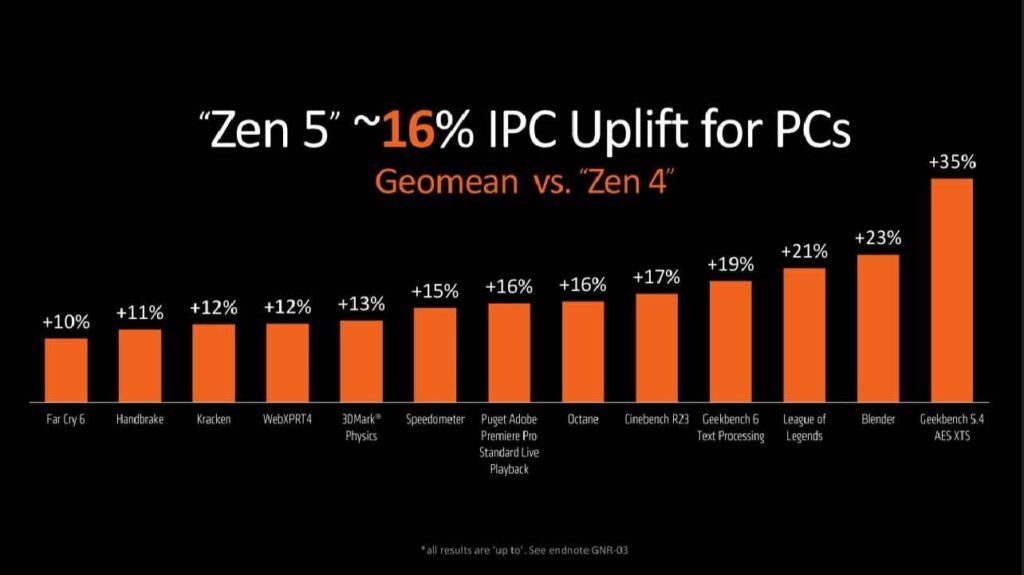At Computex 2024, AMD unveiled their new line of desktop and mobile CPUs. These boost performance, efficiency, features, and a healthy dose of artificial intelligence (AI) capabilities. They are built on the company’s most recent CPU architecture.
AMD is skipping over its existing Ryzen 7000 series and going straight to Ryzen 9000 with its upcoming desktop CPUs. The company’s most recent Zen 5 architecture, codenamed Granite Ridge, serves as the foundation for these new processors. The new CPU design, which is based on TSMC’s most recent 4nm FinFET technology, claims an average 16% increase in IPC (instructions per clock) over Zen 4.

AMD provided some fundamental information regarding this new architecture. The upgraded branch predictor offers better accuracy and latency performance, broader pipelines and vectors for increased throughput, and deeper window instruction window widths for increased parallelism. The business states that by increasing the data bandwidth between the L1 and L2 caches and increasing AI and AVX512 throughout, as well as by converting from 256-bit to 512-bit wide SIMD for AVX512, the instructions bandwidth may be increased by up to two times.
The IO die and general die arrangement are what haven’t changed. Depending on the number of cores, the Ryzen 9000 chips will continue to employ one or two CCD for CPU cores and one IO die for IO and memory functions. The IO die is still based on TSMC 6nm and is the same as the Ryzen 7000. Additionally, the integrated Radeon GPU with its two computing units is still the same.
There are four models being released today. These are the standard suspects: the Ryzen 9950X, 9900X, 9700X, and 9600X, with 16, 12, 8, and 6 core count components, respectively. The number of cores is the same as in the models from the previous generation. The 16 and 12 core models’ boost clocks are likewise comparable, however they are greater on the 8 and 6 core variants. Notably, the TDP has decreased on three of the four components as a result of the base clocks being reduced on all four parts.
As previously stated, AMD claims a 16% increase in IPC over Zen 4. When AMD compared the Core i9-14900K, Intel’s current top processor, to its new flagship 9950X, it saw improvements of up to 21% in Cinebench 2024 and up to 56% in Blender. While the business promises up to 23% greater performance in games like Horizon Zero Dawn (which previously ran better on AMD), the increase in gameplay is less pronounced. Please take these results with a grain of salt as they are obviously cherry-picked first party results.
AMD also revealed the X870 and X870E motherboard chipsets. In contrast to the X670 and X670E, all boards in the X800 series are now required to incorporate USB 4.0 and PCIe Gen 5 for SSD and graphics. Additionally, AMD is claiming faster overclocking rates for EXPO RAM; the standard JEDEC specification has been upgraded from 5200MHz on the Ryzen 7000 to 5600MHz on the 9000. Ryzen 7000 chips will be supported by motherboards from the 800 series, while Ryzen 9000 chips can be supported by motherboards from the current 600 series with a BIOS update.
AMD has extended its 2025+ to 2027+ support for AM5. This indicates that support for the upcoming third generation of CPUs—which will replace the current two—is probably in the works.
In relation to expanding support, AMD has released two new components to support its outdated AM4 platform. The Ryzen 7 5800XT and Ryzen 9 5900XT were released today. The 5800XT is a variant of the 5800X that has been upgraded to have a boost frequency of 100MHz higher and comes with a Wraith Prism cooler installed. Contrary to popular belief, the 5900XT is really a downclocked variant of the 5950X, with the same 16-core/32-thread architecture but a base clock speed and boost frequency of 100MHz fewer than the 5900X.
Finally, as part of its new Ryzen AI 300 series, AMD also unveiled two new chipsets for the laptop market. Among them are the Ryzen AI 9 365 and the Ryzen AI 9 HX 370. The new Ryzen 8000 series CPUs have up to 12 cores, which is a combination of slower Zen 5C cores and the new Zen 5 cores, as opposed to the previous generation’s 8 core maximum. Additionally, they have an NPU with 50 TOPs of speed and updated Radeon 890M graphics, which enables them to work with Microsoft’s Copilot+ capabilities. Acer, ASUS, HP, Lenovo, and MSI have all confirmed that their forthcoming laptops will support these components, so expect to see them in those models as well.
In July 2024, the new desktop Ryzen 9000 series and 5000 series components will be released. As of this writing, AMD has not disclosed any pricing information.